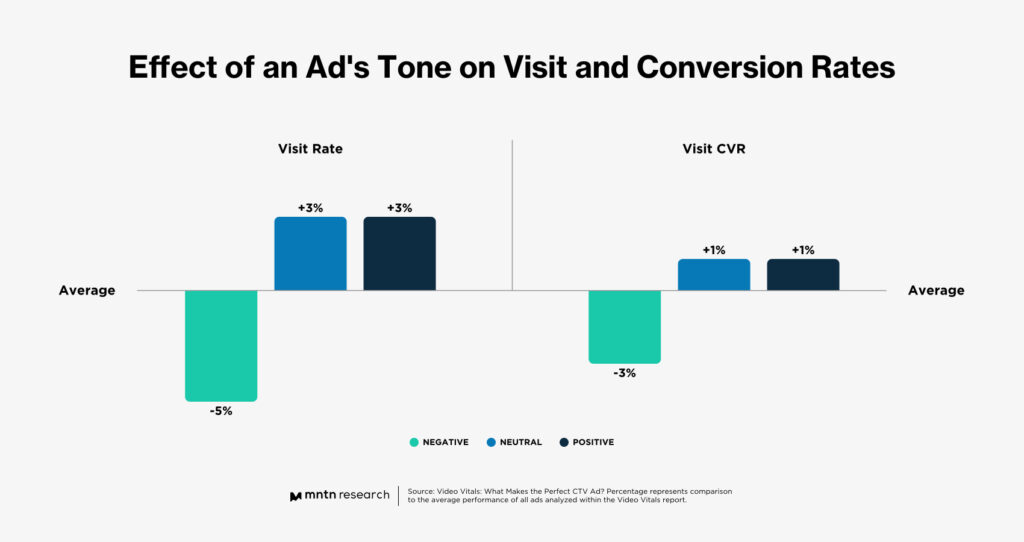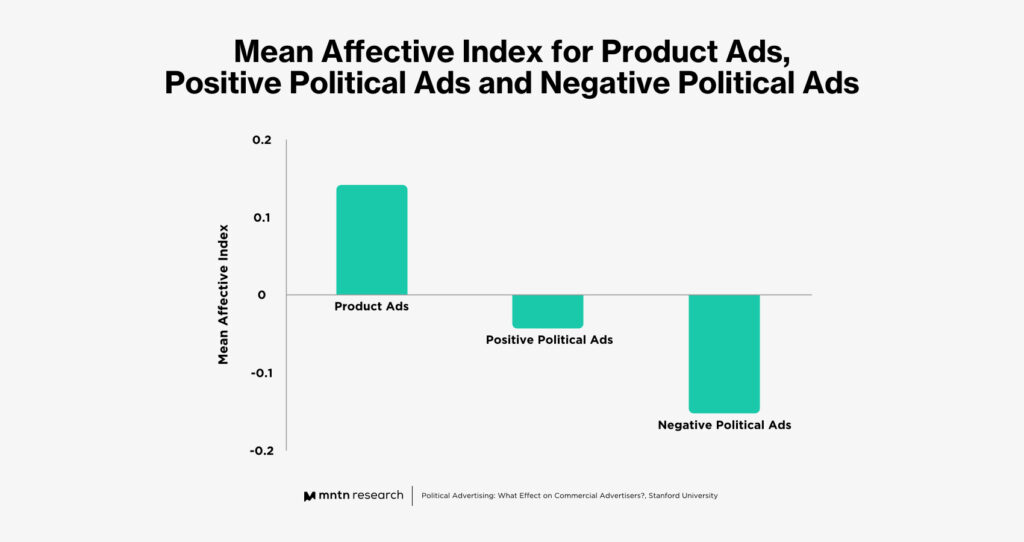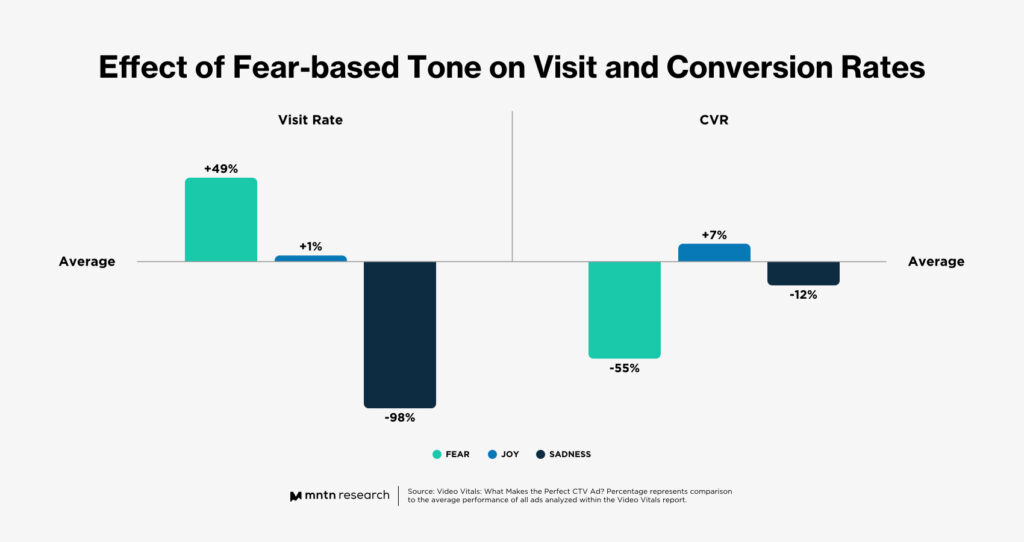Analysis
Tuning Into Tone and Emotion Drives Better Ad Performance
by Melissa Yap5 min read
Abstract
- A positive or neutral tone of voice produces stronger visit and conversion rates.
- Fear-based messaging drives higher site visits, but less users are taking action.
- Commercials that lead with optimism rather than negative emotions drive stronger Conversion Rates than average.
Your ad might be on-brand, but might not be on-tone. Research shows that employing certain emotions and tonality are the key to winning over viewers.

Re-thinking How We Think About Tone
We all know that you can’t advertise effectively without first having a solid brand foundation, but don’t expect the latter to carry all of the weight. That’s where advertising comes into play, as it bridges the gap between brands and consumers, providing a platform for brands to introduce new products and influence consumers’ decision making. Every minute detail, even an ad’s tone of voice, can elicit a certain response. Academic studies and brands alike have tried to determine which elements work (or not so much), including Video Vitals: What Makes the Perfect CTV Commercial? The report analyzed over 1,800 ads across ad length, tone of voice, number of actors and speaking roles and more, and found that overall tone can make or break marketer’s ad experience. A negative tone of voice results in the lowest performance across both site visit rate and conversion rates, while a neutral or positive tone of voice was viewed more favorably:
- Site Visits were 5% lower than average, versus a neutral or positive tone of voice, which were 3% higher than average.
- Conversion Rate was 3% lower than average, versus a neutral or positive tone of voice, which were 1% higher than average.
This suggests that a negative tone of voice, like sadness and fear, can weigh down your ad performance as much as it can your audience. However, there are some exceptions where this tone of voice can work in an advertiser’s favor—such as ad placement, or incorporating certain audible elements.
How Negative Tone of Voice Can Benefit Advertisers
It’s interesting to note that one ad’s tone can affect the ads that follow it. A study conducted by the Department of Communications at Stanford University found that watching political ads (often with a negative tone) vis-à-vis product ads actually influenced how viewers felt about the latter. This contrast increases when people see two political ads instead of only one.
The chart below shows the average affect score (on a scale between -1 and +1) across product ads, positive political ads and negative political ads. The product ads produced more pronounced positive reactions when watched next to a negative political ad.

Additionally, tone of voice extends beyond the script and messages on a screen—audiences are also sensitive to sound, which contributes equally to ad perception. Research from eConsultancy showed that even different melodies, chords or key changes in song have an influence. For example, strings playing short and sharp notes in a major key were found to elicit feelings of happiness and excitement in 87% of survey respondents, but shifting from major to minor keys provoked a sense of sadness or melancholy in 83%, and 90% found acoustic guitar sounds to be caring, calm and sophisticated.
Fear-based Messaging Drives Site Visit Rates 49% Higher Than Average

Tone and voice and emotion go hand-in-hand when determining which ads resonate (or not) with viewers. The chart above from QuickFrame by MNTN’s Video Vitals study demonstrates how different emotional-backed messaging impacts advertising performance, where negative emotions like fear drives a 49% higher visit rate, but 55% lower conversion rate. Why does fear elicit such a strong response in advertising? A research paper from the Journal of Marketing explained there are three main reasons:
- A single exposure to fear appeal messaging can induce anxiety.
- Anxiety resulting from fear appeal messaging has an ability to modify behavior.
- Seeing someone having a fearful or anxious reaction spreads those emotions to the viewer.
However, this same research study provided evidence that there is a level where viewers ‘max out’ and eventually switch off if fear tactics are overused, such as “passive helplessness” and “angry activism”. It’s important for advertisers to balance this out with positive, solution-based messaging as a call to action to both reduce the anxiety and stress on the viewer and encourage viewers to take action.
Positivity Prevails and Resonates Better Than Negative Ads
Overall, optimism is the key to a higher performing ad. The International Journal of Research in Marketing found that ads that evoked pleasant feelings stuck with consumers more than negative, neutral or information-based commercials. This feeling resonated long beyond the television ad spot aired, as they had a positive association with the brand, regardless of whether or not the product was relevant to them.
However, as fear-messaging has its limits, so too does positive-messaging. This same research paper found that positive-based advertising worked best for hedonistic, rather than utilitarian, products. Ultimately, consumers trust a brand more when an ad appeals to their desire to experience the product or service for fun instead of utility and function.
Conclusion
Negative (or fear) based messaging and positive based messaging appeal to viewers in different ways. While each of these have their pros and cons, advertisers should also respect that there may be limitations towards both of these types of messages, if either of these emotions are overused.
Subscribe to the MNTN Research Weekly
Sign up to receive a weekly feed of curated research, sent straight to your inbox.
Resources
1 Video Vitals Analysis Data (QuickFrame by MNTN)
2 Does Negative Advertising Work? (University of Otago)
3 Science of Sound: How Music Makes Advertising More Memorable (eConsultancy)
4 Political Advertising: What Effect on Commercial Advertisers? (Stanford University )
5 Fear Appeals in Marketing. A Social Perspective (Journal of Marketing)